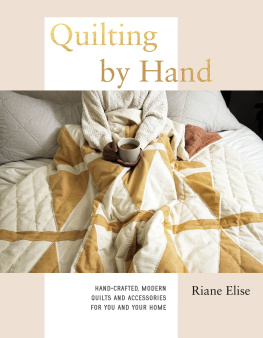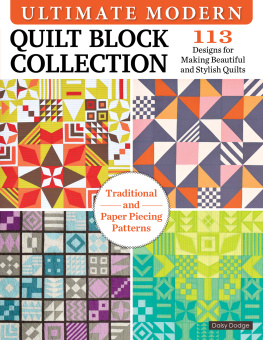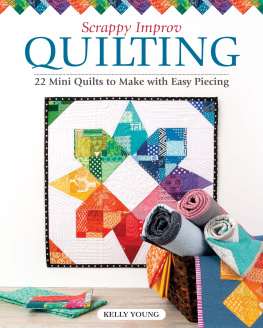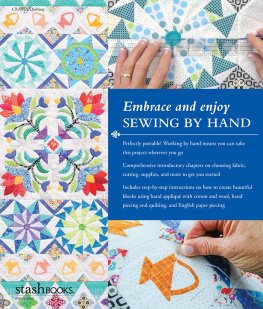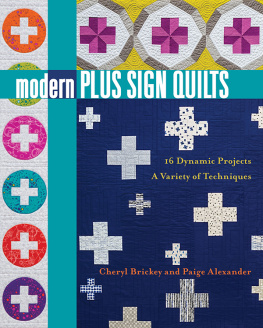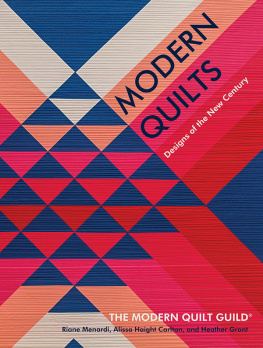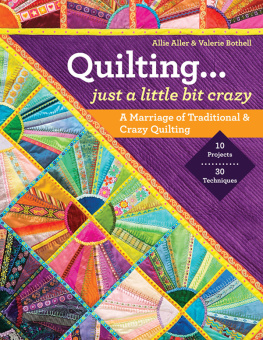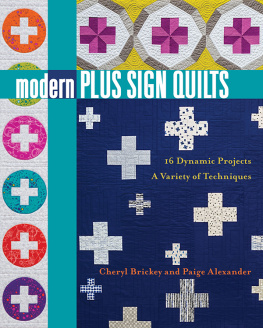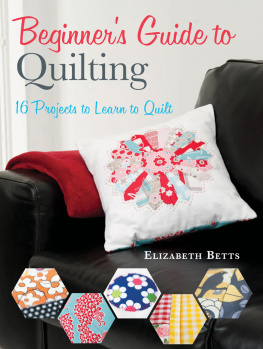
APPLIQU To sew one piece of fabric to the top of another piece of fabric.
BACKING The bottom or back layer of a quilt.
BACKSTITCH To sew backwards by one or several stitches, either by hand or machine. Often used to secure or stabilize a seam.
BASTING To temporarily hold all the layers of a quilt together while quilting. Often done using safety pins or basting stitches. Also called tracking.
BATTING The lofty inner layer of a quilt, often made from wool or cotton. Also called wadding.
BINDING To finish a quilt by enclosing its raw edges with fabric after quilting. Often the last step of the quilting process.
BLIND STITCH A useful stitch for appliqu and binding. To make a blind stitch, start by tying a knot in one end of your thread. Bring the needle and thread up through the layers you are sewing, catching the binding or appliqu fabric. Insert the needle through the background or backing fabric close to the prior insertion point, and bring the needle up through the binding or appliqu fabric again about in (36mm) away from the prior stitch. Repeat to continue the stitch.
FRENCH KNOT An embroidery stitch made by wrapping thread around the needle. This stitch can be used for hand tying quilts.
INVISIBLE STITCH A type of hand stitch used for binding and appliqu, which produces small, almost invisible stitches.
MARKING Using a marking tool to draw a stitching line on fabric, often used to mark hand piecing or quilting lines.
MARKING TOOL A pen, pencil, marker or hera marker used for marking quilting or stitching lines. Often erasable or temporary.
PATCHWORK A name for a section of fabric or quilt top that has been constructed by sewing multiple pieces of fabric together.
PIECING The practice of sewing individual fabric pieces together to create patchwork.
PINS Straight pins are used to hold fabric together during the piecing or patchwork process. Safety pins are used to baste the layers together for quilting.
PRESSING Using a hot iron to smooth out seams or fabric.
QUILT SANDWICH The three layers of a quilt backing, batting or wadding and the quilt top.
QUILTING To stitch all layers of a quilt together with thread.
QUILTING LINES Marked lines on a quilt top that indicate where one should place quilting stitches.
QUILTING RULER Often featuring a clear plastic face and lines at in intervals. A quilting ruler is a great tool for cutting fabric pieces and for marking piecing and quilting lines.
SASHIKO A style of Japanese visible stitching. While not specifically made in the Japanese sashiko style, quilts in this book were made using sashiko needles and thread.
SEAM ALLOWANCE The excess fabric left after sewing two pieces of fabric together. In quilting, the standard seam allowance is in.
SQUARE UP To trim the quilt to its finished size after quilting. This is one of the last steps, right before binding.
STITCH LENGTH The length of a stitch on the top and bottom (can refer to machine-made or handmade stitches).
TOPSTITCH To sew a line of stitching over the top of your fabric, usually with a machine. Most commonly used for finishing seams and hems.
TEMPLATES Shapes traced onto fabric and cut out to form patchwork pieces that are difficult to cut with a standard quilting ruler.
TYING To finish a quilt with small stitches that are tied using a square knot.
WADDING See batting.
WALKING FOOT A sewing-machine attachment that feeds fabric more evenly through a sewing machine. It is especially helpful for binding or sewing over several layers of fabric, or over a quilt sandwich.
WHIPSTITCH A useful stitch for appliqu and binding. To make a whipstitch, start by tying a knot in one end of your thread. Bring the needle and thread up through the layers you are sewing, catching the binding or appliqu fabric. Insert the needle through the background or backing fabric about in (36mm) away from the prior stitch. Bring the needle up again about in (36mm) away from the prior stitch. Repeat to continue the stitch.
The fabric used in this book was generously supplied by Robert Kaufman Fabrics, and includes selections of Essex Linen, Essex Yarn-Dyed Linen and Brussels Washer Linen Blend. The batting is Dream Wool by Quilters Dream. The hand-quilting thread is sashiko thread by Upcycle Stitches, including commercially manufactured threads by Coron Thread Company and naturally hand-dyed threads by Keiko Futatsuya of Sashi.Co.
FABRICS USED IN THIS BOOK
Robert Kaufman Essex Ivory wide (E024-1181)
Robert Kaufman Essex Natural wide (E024-1242)
Robert Kaufman Essex Yarn-Dyed Lingerie (E064-843)
Robert Kaufman Essex Peach (E014-1281)
Robert Kaufman Essex Leather (E014-178)
Robert Kaufman Essex Ochre (E064-1704)
Robert Kaufman Essex Putty (E014-1303)
Robert Kaufman Brussels Washer Yarn-Dyed
Redrock (B142-553)
Robert Kaufman Brussels Washer O.D. Green (B031-1256)
BATTING
Quilters Dream Wool by Quilters Dream
THREAD
Kakishibu Sashiko Thread by Keiko Futatsuya of Sashi.Co (#K3, Kakishibu Brown/Beige)
Natural Dye Sashiko Thread by Keiko Futatsuya of Sashi.Co (#013m, Western Madder)
Natural Dye Sashiko Thread by Keiko Futatsuya of Sashi.Co (#004, Tangala)
Coron Thread Company Original White (#10), obtained in partnership with UpCycle Stitches
Wonderfil Konfetti 50-weight Egyptian Cotton, various colours
Aurifil 50-weight cotton thread, various colours
NEEDLES
Tulip Sashiko Needles Assorted Long Tulip Needles (#THN-030E)
John James Sharps, size 3/9 (#JJ11039)
Special thanks to the team at Robert Kaufman Fabrics for helping to make the quilts in this book come to life with their beautiful fabric.
upcyclestitches.com
robertkaufman.com
wonderfil.ca
aurifil.com
en.tulip-japan.co.jp
jjneedles.com
Shop the supplies from this book at materialgoods.us.
UK SUPPLIERS
raystitch.co.uk
eternalmaker.com
thesewingstudio.co.uk
merchantandmills.com
AUSTRALIAN SUPPLIERS
sewmondo.com.au
scribblygumquiltco.com
thenextstitch.com.au
myfabricology.com.au
This book would not be possible without the help and support of some incredible people. I owe them all my gratitude (and a glass of wine the next time we meet).
Thank you to my amazing family for instilling in me a love of making. Thank you, Mom, for making that first quilt for me, for providing creative outlets from before I can remember and for teaching me the art of mental toughness. Thank you, Dad, for the endless maths lessons and for promising me that one day they would come in handy (I hate that you were right). Thank you to my grandmothers Gerry, who taught me how to quilt, and Betty, who always has one of my quilts on the bed, or my latest work on the coffee table. And thank you to all the others who have supported me in so many ways on my journey.
Thank you to my sister, Erin, for being my go-to creative advisor and my first critic and consultant about all things design. You keep me inspired and grounded, and Im still learning from you what it means to be content in work and in life.
To my quilting friends, Molly and Amanda, thank you for being some of the first to see the designs and cheering me on throughout the process, especially during the hard times. Thank you to Jessie, Erin and Carol, for always being there for me, no matter what. Thank you to Yvonne for once again working your magic to make these patterns airtight. You're the absolute best. And thank you to Deb, my quilting guide, my forever cheerleader, and one of my best friends and mentors for setting my feet so firmly and confidently on this path.
Next page
